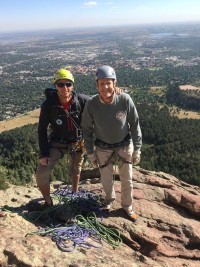A Full-Body Workout
True, Functional Total Body Strength
- Low Impact, Big Results: Rock climbing is unlike jogging, tennis and many other activities. It doesn't impact your joints in a harsh, jarring manner or require sudden jerky movements, but it sure builds endurance and strength.
- Functional Strength: Daniel Kunitz describes modern weight machines: "They were devised to make exercise easier. By isolating muscles, they did the work of stabilizing for you, fixing your joints in place and removing your core from the process. Traditional gym movements are geared to the lowest cognitive denominator: bicep curls, crunches, reading Us Weekly while plying the elliptical. The new attitude toward fitness is that mind and body are best improved through the labor of skill development." To paraphrase Daniel, climbing "builds important neuromuscular connections, integrating mind and body in a profound way." Building functional strength requires the use of all those small but very important stabilizing muscles throughout your body and must fully engage your core. The whole-body exercise, balancing and accuracy of movement involved in climbing are powerful generators of true functional strength.
- Grip Strength: I experienced a dramatic increase in my forearm and grip strength after a month or two of climbing once a week or so. You will too.
- Arms and Shoulders: Legs and feet are the most important source of climbing power, but your arms and shoulders will definitely gain strength as you pull on handholds and begin to challenge yourself on more difficult climbs.
- Legs and Hips: Do you walk on your arms and hands or your legs and feet? In rock climbing, like ladder climbing, your legs provide much of the power. Climbing up a corner route strengthens your hip muscles as you use them for stemming (a fun technique that's also great for resting during a climb).
- Core and Back: Climbing is a true full-body exercise; you will use all of your muscles. A strong abdomen, torso and back (your core) is a major benefit of indoor climbing.
- Weight Loss: Rock climbing is fun, and even more fun when you weigh less! It's certainly the best incentive for weight loss that I've ever found.
- Balance: As your climbing skills progress, your body awareness and balance improve. You quickly learn that balance and center of gravity awareness is an essential part of climbing and significantly reduces the effort required to reach the top. Losing your balance in other activities means a fall and possible injury. Losing your balance in top-rope climbing simply means sitting back in your harness, secured by the high-tech rope and the anchor at the top of the route.
- Important CDC Facts About Falls: Each year, 2.5 million older people are treated in emergency departments for fall injuries and over 700,000 are hospitalized. Direct medical costs for falling are $34 billion annually, and falls are the most common cause of traumatic brain injuries. Balance training is a big part of what climbing is all about, making it a highly effective fall prevention activity. It's an unfortunate paradox - the group (older adults) most at risk of falling typically won't consider trying this highly effective agility and balance-building activity.
- Flexibility: Reaching and stretching while attempting to conquer climbing routes certainly increases your flexibility. During your normal daily life you would never stretch, twist and reach as much as you do when climbing! However, you're so focused and having fun you don't realize how much your flexibility is being exercised.
- Endurance: As your skills improve and you attempt more difficult routes, climbing becomes more intense. You may fail to reach the top but your stamina and cardiovascular health are succeeding! My resting heart rate is now in the low 60's; 20 beats/minute, 28,000 beats/day and 800,000 beats/month less than when I started climbing.
- Quality of Sleep: When I climb for a couple of hours I know I’ll enjoy a deep, restful sleep that night - and maybe an afternoon nap!
- Cautions: Indoor rock climbing strengthens muscles rapidly, often faster than your tendons and ligaments. Warm up before climbing; improve gradually as you have fun and lose weight. Climb within your abilities and do the pre-climb risk management checks with your partner - every time on every climb.
- Muscle Soreness: You will get sore, so be patient and don't overdo your climbing sessions at first. Handholds are textured to help your grip but may make your hands a bit sore. Top Tip: tight-fitting golf gloves with partly cut-off fingers or exercise gloves offer good hand protection. As your fitness improves, muscle soreness will ease.

